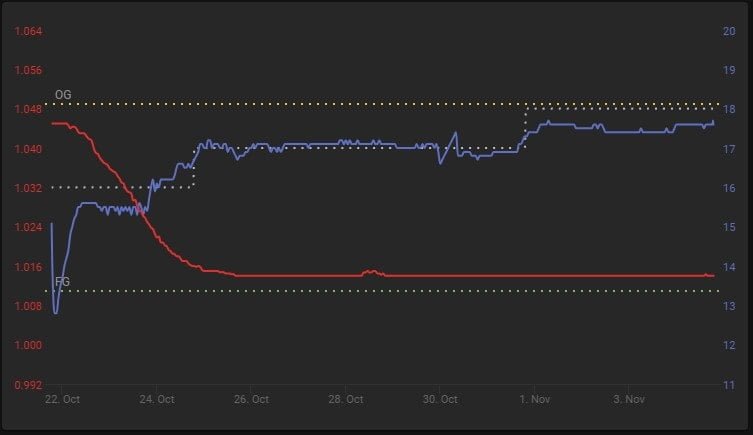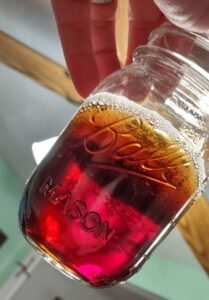Schwarzbier
What is schwarzbier? According to the BJCP guidelines (2021), it is “a dark German lager that balances roasted yet smooth malt flavors with moderate hop bitterness.”
| BJCP Category | 8B |
| ABV | 4.4–5.4% |
| Original Gravity (OG) | 1.046–1.052 |
| Final Gravity (FG) | 1.010–1.016 |
| IBU | 20–35 |
| Color (EBC/SRM) | 19–30 SRM |
One Way to Brew A Schwarzbier
I found this Schwarzbier recipe while reading Craft Beer & Brewing magazine (which I usually check out from my local library when a new issue comes out). This beer made by Zoiglhaus in Portland, OR won a silver medal at the 2018 Oregon Beer awards. The write-up for this style in CB&B piqued my interest, so I gave this Schwarzbier recipe a go. You can find the recipe for Zoiglhaus Zoigl-Black from Craft Beer & Brewing here (it is a “Subscriber Exclusive”, so if you don’t have a membership, go to your local library and see if they have Craft Beer & Brewing on the magazine rack–it’s the Spring 2023, Issue 56, look for page 41).
Batch Vital Statistics
| Stat | Value |
|---|---|
| Batch Volume | 19 L |
| OG | 1.049 |
| FG | 1.014 |
| ABV | 4.9 % |
| Color | 40 EBC |
| IBU | 30 |
| Boil Time | 60 minutes |
Recipe
Water Profile
Usually when I find beer recipes in magazines or books, the water profile (or concentrations of various ions) isn’t mentioned, so I liked this write-up in CBB for this Schwarzbier recipe from Zoiglhaus. “The minerality of water helps to build the beer’s underlying structure as well as achieve the correct mash and wort pH.” To read more about water chemistry used in brewing, check out my Something in the Water: Water Chemistry for Homebrewing article.
| Ca2+ (ppm) | Mg2+ (ppm) | Na+ (ppm) | Cl– (ppm) | SO42- (ppm) | HCO3– (ppm) | pH |
|---|---|---|---|---|---|---|
| 82 | 0 | 71 | 98 | 67 | 179 | 5.4 |
To reach the target water profile, I added half of a Campden tablet, 5.1 g calcium chloride, 3.1 g calcium sulfate, 6 g sodium bicarbonate, and 4.5 mL lactic acid to 26.2 L reverse osmosis water.
After heating the water to 64 °C, 7 L of the treated water was removed to reserve as sparge water.
Fermentables
One of the main characteristics of a Schwarzbier is the hint of roast that is absent of any harshness. It is important to use huskless (de-husked) roasted malts for this beer. Without the husks, this class of roasted malts provides less bitterness and astringency. For this recipe, I’m using Carafa Special II from Weyermann.
| % | kg | lb | Grain/Adjunct |
|---|---|---|---|
| 77.8 | 3.175 | 7 | BestMalz Pilsen |
| 10.1 | 411 g | 0.9 | BestMalz Munich Dark |
| 6.6 | 269 g | 0.6 | BestMalz Caramel Hell |
| 5.6 | 227 g | 0.5 | Weyermann Carafa Special II |
Mash Profile
The mash profile for this recipe includes a variety of step mash steps that aid in the fermentability of the wort.
Milled grains were slowly added to the strike water while thoroughly stirring the grain into the water to ensure all of the grain was wet.
After 10 minutes into the mash, I took an aliquot and cooled the sample to 22 °C. The pH measured was 5.48.
| Step | Temperature (°C) | Temperature (°F) | Time (minutes) |
|---|---|---|---|
| Saccharification Rest (β-amylase) | 62 | 144 | 55 |
| Saccharification Rest (β- and α-amylase) | 68 | 154 | 35 |
| Saccharification Rest (α-amylase) | 72 | 162 | 25 |
| Mash-out | 78 | 172 | 5 |
After mashing out, the grains were sparged, or rinsed, with water. First wort hops were added.
The wort was then heated to a boil.
Hops
| Hop | Alpha Acid | Time | IBU |
|---|---|---|---|
| Magnum | 14.0% | First Wort Hops (FWH) | 25 |
| Hallertau Mittelfrüh | 2.7% | 30 minutes | 5 |
Yeast
For this recipe, I used W-34/70 from Fermentis.
The wort was chilled to 20 °C and transferred to a Kegland Fermzilla All Rounder 30L fermentor. Using an aquarium pump submerged in an ice bath, water was circulated through a Kegland Temp Twister until the wort was chilled to 13 °C. The yeast was pitched into the wort and a spunding valve was applied, set at a release pressure of 10 psi.
The fermenting beer was allowed to rise to 16 °C and was held at that temperature for 3 days before the temperature was raised to 17 °C. After 7 days, the temperature was raised to 18 °C for 4 days.
Fermentation Profile
| Step | Temperature (°C) | Temperature (°F) | Time |
|---|---|---|---|
| Primary | 16 | 61 | 3 days |
| Primary | 17 | 63 | 7 days |
| Primary | 18 | 64 | 4 days |

Conditioning and Carbonation
After fermentation, the beer was transferred to a keg, pressurized to 14 psi, and allowed to lager at 3 °C for 3 weeks.
| Step | ||
|---|---|---|
| Lagering | 3 °C/37 °F | 21 days |
| Carbonation | 14 psi | 2.7 volumes of CO2 |
Recipe Impressions
This Schwarzbier pours a dark brown with a tan-colored head. When held to the light, I see beautiful ruby highlights. There is also excellent clarity.


For aroma, I get bread with a hint of roasted coffee or chocolate. The mouthfeel is a smooth, medium-light body, with no harshness from the roasted malt. This Schwarzbier has a clean, bread-like flavor with a refreshing hint of roast and chocolate.
Before brewing this beer, I have only had a few examples of Schwarzbier. When finding Schwarzbier at American craft breweries, I usually find the beer was crafted using a heavy hand with roasted malts. But this version is delightful. I could drink this Schwarzbier all year long.
Do you enjoy Schwarzbier? Let me know what you like or dislike about this style in the comments below!
